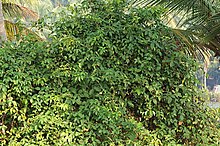|
Derris trifoliata
Derris trifoliata is a plant species in the genus Derris of the family Fabaceae. It common in India and in various Indian languages it is known as Angaar valli in Sanskrit; Karanjvel in Marathi; Firta in Konkani; Tigekranugu, Nauatige and Chirathelathige in Telugu; Ketia and Swanlata in Oria; Kammattivalli and Ponumvalli in Malayalam; Kaliya lata or Kalilata and Panlata in Bengali; Panlata also in Hindi. It is also common in various parts of South East Asia with names eg Filipino (asiasimanan (Tagalog)); Indonesian (tuwa areuy (Sundanese)); Malay (Akar Ketuil, Ketui, Setui, Salang, tuba bekut or Sea Tuba (Peninsular)); Thai (phak thaep (central)); Vietnamese (c[os]c k[es]n n[uw][ows]c) etc. It is a large climber found commonly in coastal swamps of tropical coastal areas in South-East Asia. It is 3–5 meters long. Its leaves are alternate, pinnate, 12–20 cm; leaflets 5, ovate, 6-10 com, acuminate, rounded at base. Flowers are 1 cm in size, in axillary racemes 8–15 cm. Pods are 3–4 cm, flat, pale yellow in color. The rotenoid 6aα,12aα-12a-hydroxyelliptone can be found in the stems of D. trifoliata.[1] In 1902 Kazuo Nagai, Japanese chemical engineer of the Government-General of Taiwan, isolated a pure crystalline compound from a closely related plant possibly Derris elliptica which he called rotenone, after the Taiwanese name of the plant 蘆藤 (Min Nan Chinese: lôo-tîn) translated into Japanese rōten (ローテン). Derris pod, root, stem all are rich in poisonous rotenoids and used commonly in insecticide, piscicide and pesticide activities and also have sometimes caused human morbidity or mortality due to suicide attempts or accidental ingestion. The larvae of Hasora hurama feed on D. trifoliata. Gallery
ReferencesWikimedia Commons has media related to Derris trifoliata. Wikispecies has information related to Derris trifoliata.
|
||||||||||||||||||||||||||||||||||



